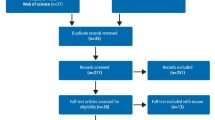Abstract
Data sources The review searched for articles via Medline up to March 2019 for English language papers only.
Study selection Two authors screened the reviews initially against the inclusion and exclusion criteria. Discrepancies were discussed with all authors for the final decision. Due to a low number of higher-level studies on non-operative caries management (NOCM; excluding silver diamine fluoride [SDF]), studies other than randomised controlled trials, systematic reviews and meta-analyses were included to allow some collation of evidence for an overview to be gained.
Data extraction and synthesis Data extracted included setting, participants, focused question, search results, comparators, main outcomes and conclusion. Data for SDF was collated separately to other NOCM due to the higher level of evidence and its use in cavitated lesions as well as non-cavitated carious lesions.
Results Five systematic reviews investigated SDF use. All the reviews demonstrated SDF to be an effective management tool for arresting early caries. Ten studies looked at NOCM, which showed fluoride varnish has a moderate effect on arresting carious lesions, but the evidence was of low level. For restorative approaches, a low level of evidence showed resin restorations to have a higher failure rate than composite strip crowns, regardless of general anaesthesia, and more so than stainless steel or zirconia crowns.
Conclusions SDF is an effective tool in the management of early childhood caries.
This is a preview of subscription content, access via your institution
Access options
Subscribe to this journal
Receive 4 print issues and online access
$259.00 per year
only $64.75 per issue
Buy this article
- Purchase on Springer Link
- Instant access to full article PDF
Prices may be subject to local taxes which are calculated during checkout
Similar content being viewed by others
References
American Academy on Pediatric Dentistry. Policy on early childhood caries (ECC): classifications, consequences, and preventive strategies. Pediatr Dent 2018; 40: 60-62.
Gussy M, Waters E, Walsh O, Kilpatrick N. Early childhood caries: Current evidence for aetiology and prevention. J Paediatr Child Health 2006; 42: 37-43.
Tinaoff N, Baez R, Guilory C et al. Early childhood caries epidemiology, aetiology, risk assessment, societal burden, management, education, and policy: Global perspective. Int J Paediatr Dent 2019; 29: 238-248.
Corrêa-Faria P, Viana K, Raggio D, Hosey M, Costa L. Recommended procedures for the management of early childhood caries lesions - a scoping review by the Children Experiencing Dental Anxiety: Collaboration on Research and Education (CEDACORE). BMC Oral Heath 2020; 20: 75.
Author information
Authors and Affiliations
Rights and permissions
About this article
Cite this article
Crowder, L. Management options of early childhood caries. Evid Based Dent 22, 106–107 (2021). https://doi.org/10.1038/s41432-021-0197-8
Published:
Issue Date:
DOI: https://doi.org/10.1038/s41432-021-0197-8



